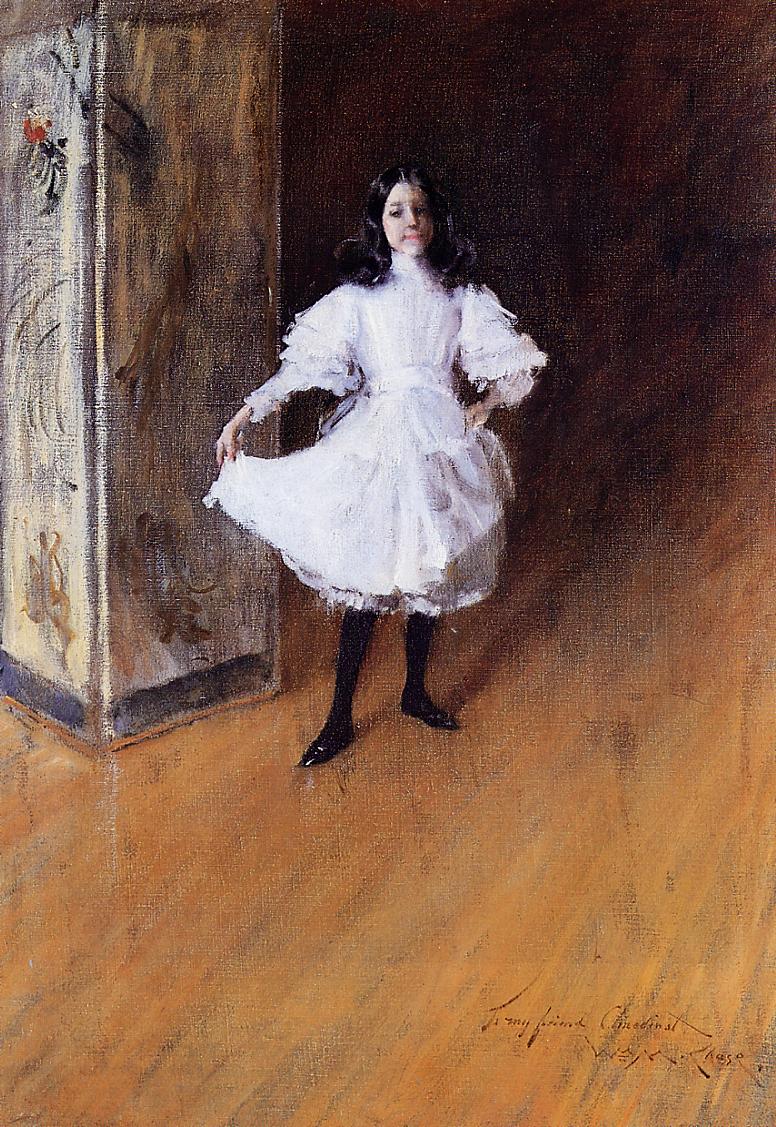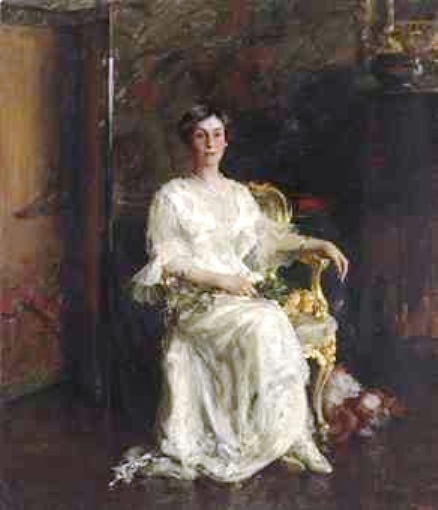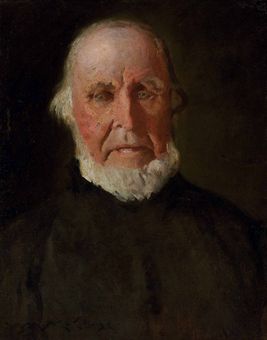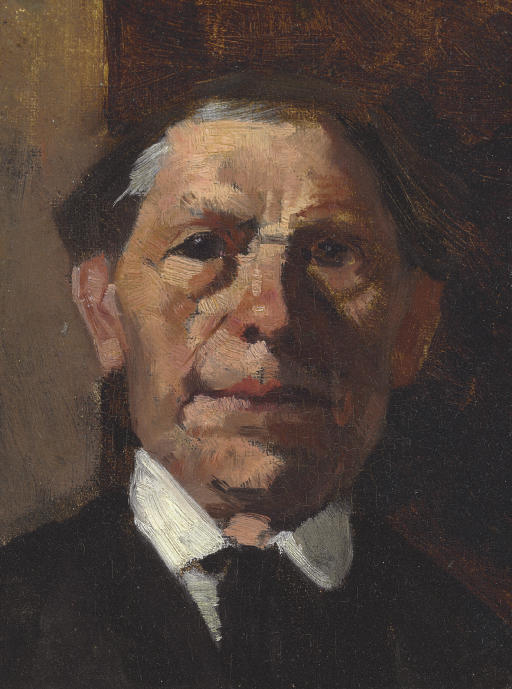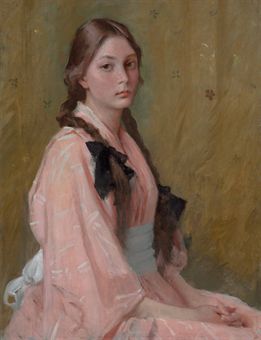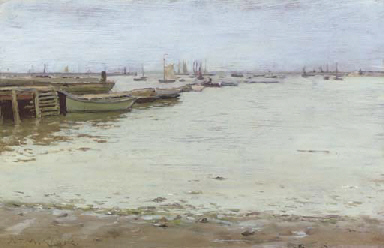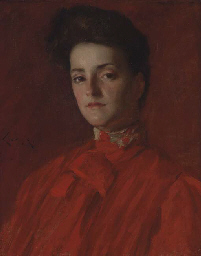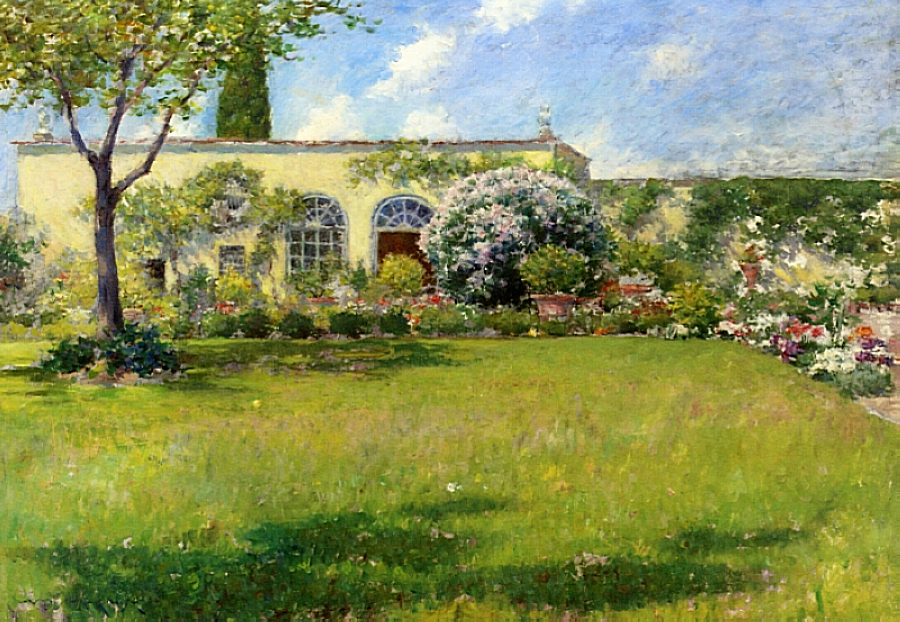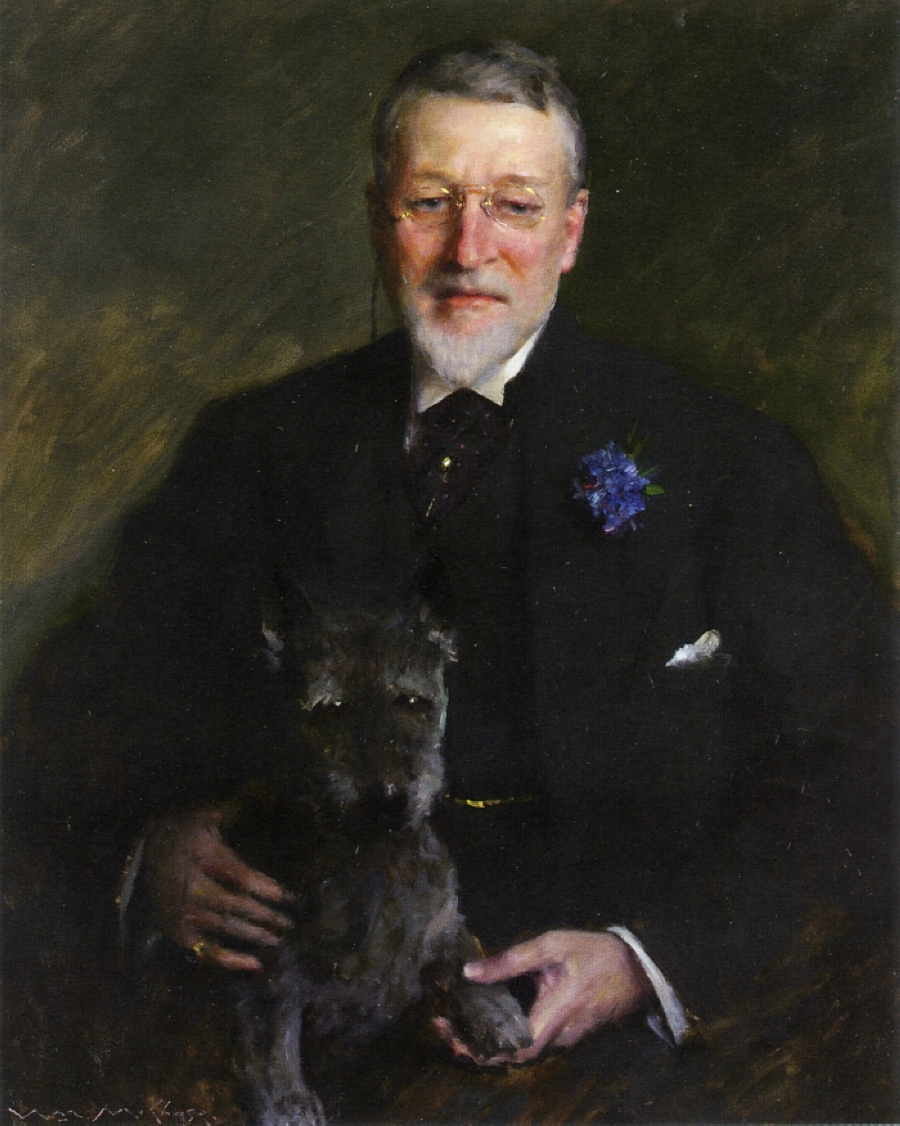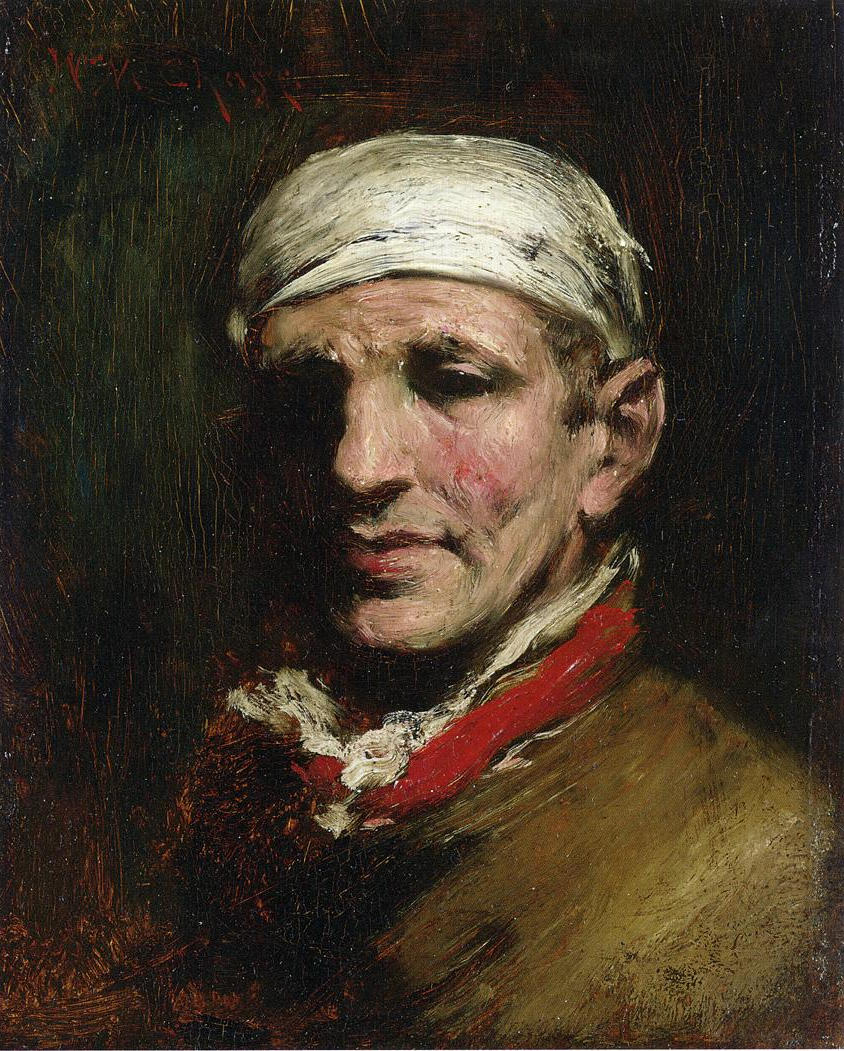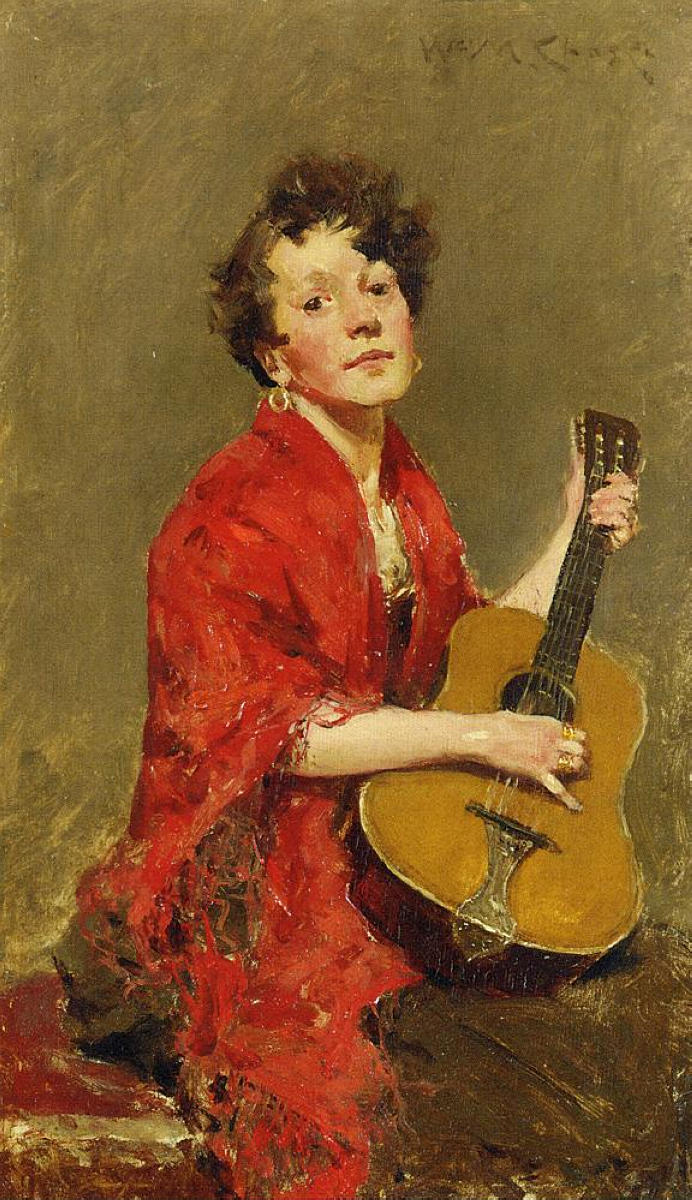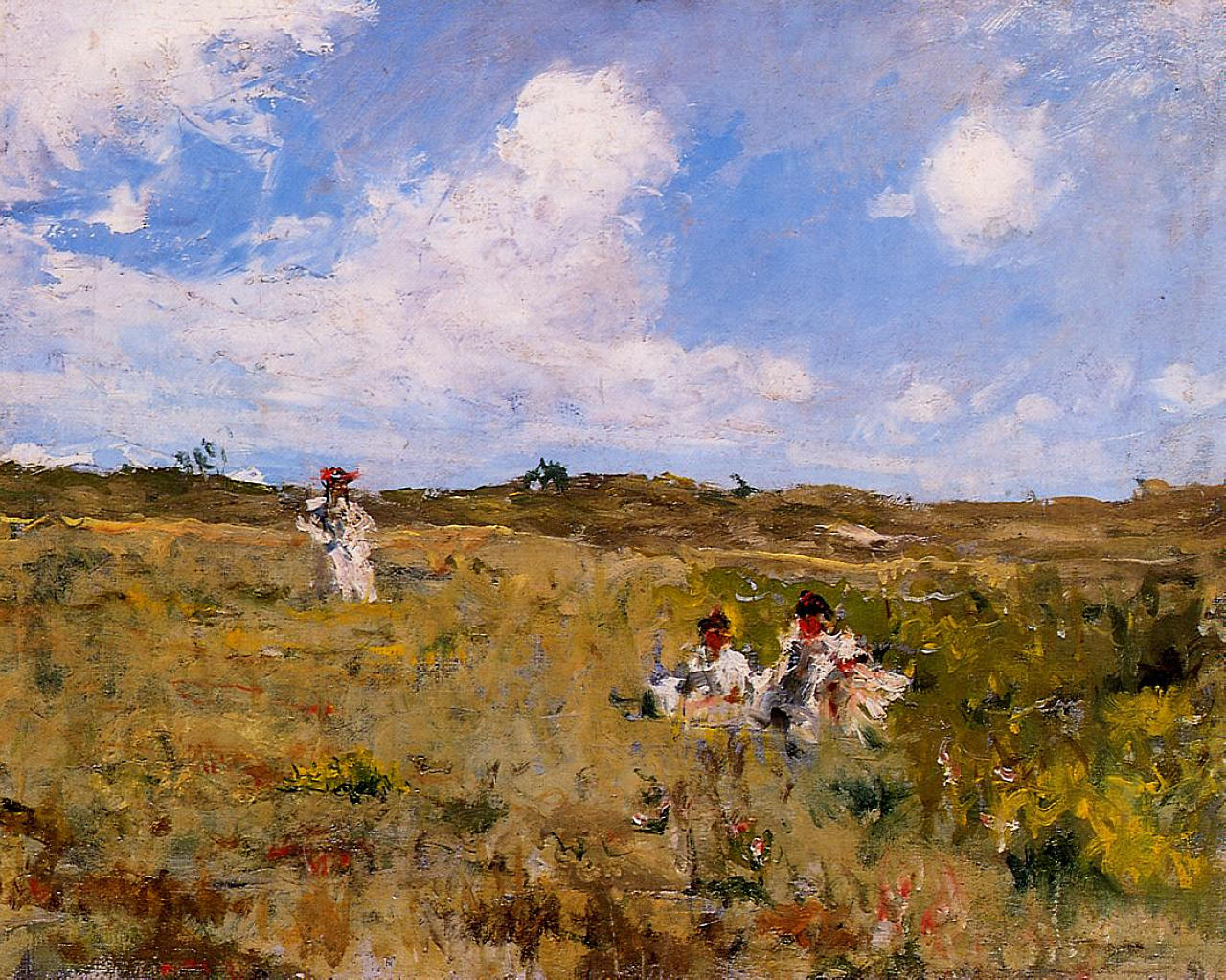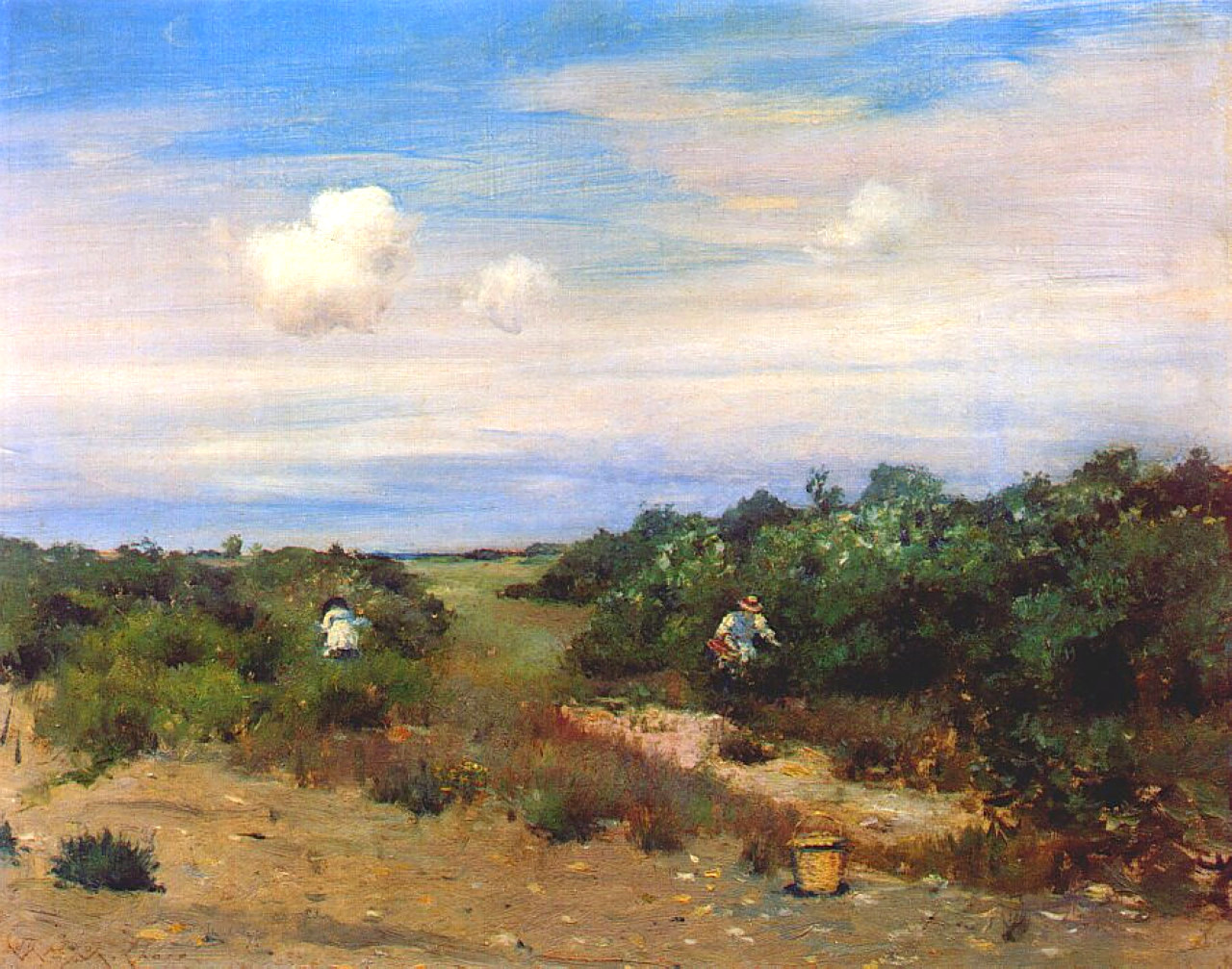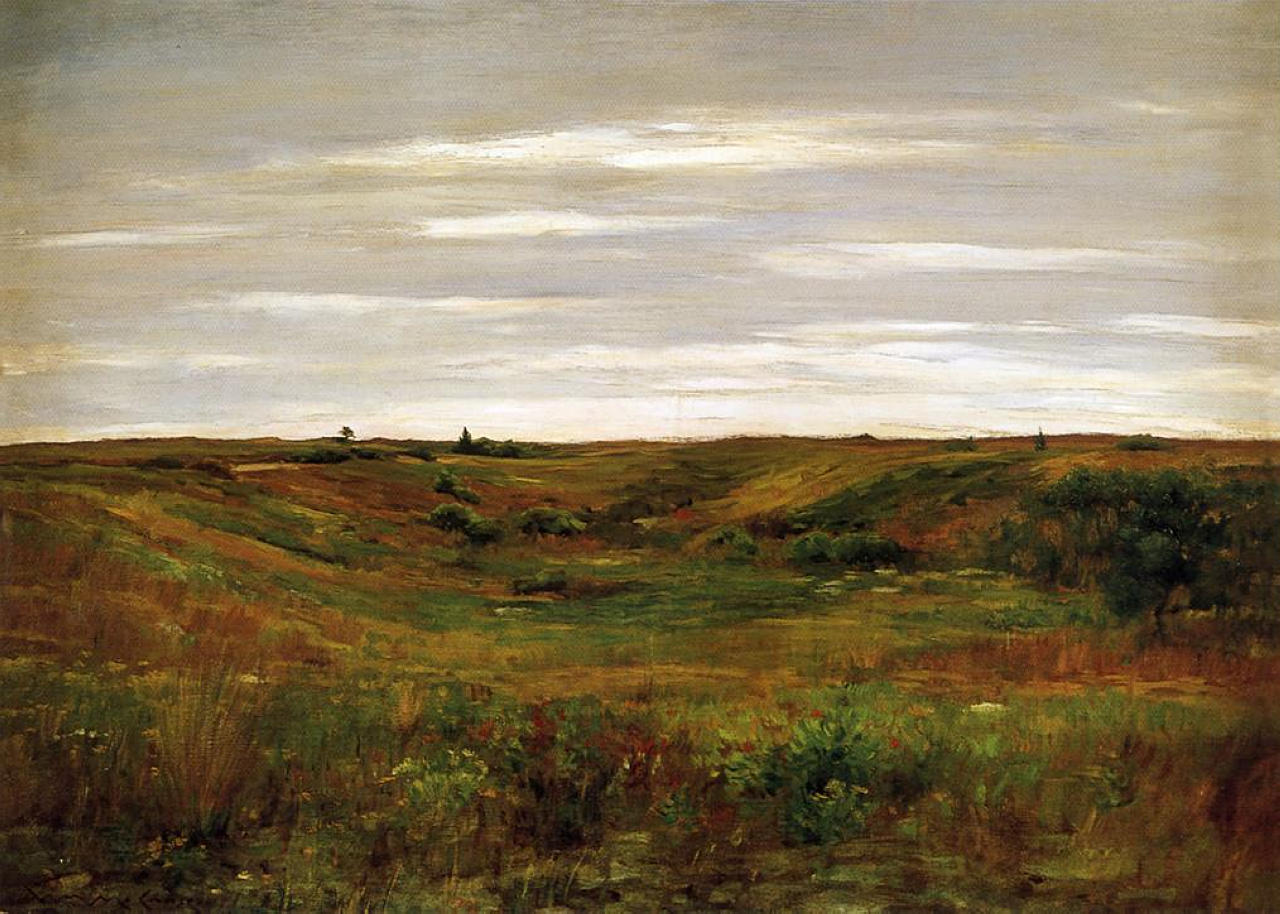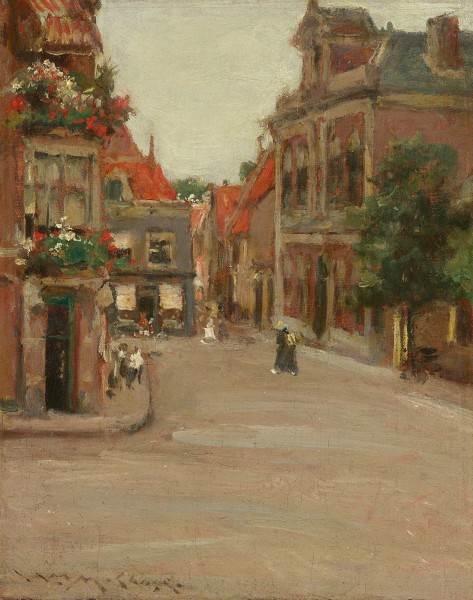-
Biography - National Gallery of Art
William Merritt Chase was born in Williamsburg (later Ninevah), Indiana,
in 1849, the oldest of six children. When he was twelve, the family moved
to Indianapolis. His father hoped that he would follow him into the women's
shoe business, but Chase, who said "the desire to draw was born in me,"
resisted his father's commercial ambitions for his own artistic ones. In
1867 he began his training with Barton S. Hays, followed two years later
with study at the National Academy of Design in New York under Lemuel P.
Wilmarth.
In 1871 Chase moved to Saint Louis, where he painted still lifes
professionally. He attracted the attention of local patrons, who, in the
fall of 1872, offered to send him abroad. At the Royal Academy of Fine Arts
in Munich, where he received his most decisive training, Chase was one of
the many Americans, including Frank Duveneck and later John Twachtman,
studying there.
After an extended visit to Venice with Duveneck and
Twachtman in 1878, Chase returned to New York, where he began teaching at
the Art Students League. He devoted much of his time and energy to
teaching, not only at the League, but also the Brooklyn Art Association,
the Pennsylvania Academy of the Fine Arts, the Shinnecock Summer School of
Art, and the New York School of Art the last two of which he founded and
was the most celebrated teacher of his time.
As a leader of the insurgent
younger painters who challenged the authority of the National Academy of
Design, he was a founding member of the Society of American Artists and, in
1880, was elected its president. His large, sumptuously decorated studio in
the Tenth Street Studio Building, which he took soon after his return to
New York, was the most famous artist's studio in America and a virtual
manifesto of his and his generation's artistic practices and beliefs, and
of the dignity of the artist's calling.
In 1886 he married Alice Gerson, who was frequently his model, as were
their many children. Chase painted a wide range of subjects, including
figures, landscapes and cityscapes, studio interiors, still lifes, and,
increasingly later in life, portraits, and he worked with equal brilliance
in oil and pastel. Chase died in New York City in 1916.
Biography - Questroyal Fine Art, LLC, New York, New York
A leading American impressionist and respected art instructor,
William Merritt Chase was responsible for pioneering the plein-air
movement in the United States.
By Chelsea DeLay
I. Biography
II. Chronology
III. Collections
IV. Notes
V. Suggested Resources
I. Biography
William Merritt Chase was born in the small town of Williamsburg,
Indiana, on November 1, 1849. After his family moved to Indianapolis in
1861, the young teenager spent several years working as a salesman in
his father’s store, David H. Chase Boots Wholesale and Retail.(1) When
it became clear that Chase’s interest in drawing overshadowed any
possibility of working in retail, his exasperated parents relented and
allowed him to train under the self-taught painters Barton S. Hays and
Jacob Cox. At the age of eighteen, Chase and a friend briefly enlisted
in the Navy Apprentice program, yet after only three months of being
assigned to the USS Vermont and USS Portsmouth, Chase sent a letter to his father asking to arrange his discharge.(2)
When the two arrived back to Indianapolis, a room in the family home
was given to Chase to use as his studio where he resumed lessons with
Hays and Cox. However, his former instructors soon realized that Chase’s
artistic abilities had matured beyond what they could teach him; they
encouraged the young artist to continue his education under the
instruction of their colleague, Joseph O. Eaton, a professor at the
National Academy of Design. An eager student, Chase moved to New York
City in 1869 and enrolled in the school’s fall session, along with
classmates Julian Alden Weir and Albert Pinkham Ryder. The next year
Chase was faced with a difficult reality when his father’s business
folded—left without his father’s financial support, he earned money to
support himself by painting fruit and flower still lifes and portraits
in Yonkers, New York.(3)
Chase experienced mild success selling his work on the competitive
New York art market, but recognized that the Midwest possessed a greater
potential for offering better commissions. After his father went out of
business, the Chase family relocated to Missouri, and by the fall of
1870 Chase had reunited with them in St. Louis and established a studio.
He won two awards at the 11th St. Louis Fair in 1871, and his work
caught the attention of local businessmen and art patrons; one banker
described his perception of the twenty-one-year-old artist, stating,
“There is a young man here who paints so well that I dare not tell him
how good he is.”(4) Several of these wealthy merchants knew of Chase’s
strong desire to continue his education abroad, and recognizing his
artistic potential, they offered him a two-year stipend to study at the
Royal Academy in Munich.
Chase left for Europe in 1872 and would not return to the United
States until 1878. During these six years abroad, he painted with the
dark colors and somber tones typical of the Munich School, and developed
an immense passion for collecting art. When he returned to New York
City, he occupied the former studio of Albert Bierstadt in the famous
Tenth Street Studio Building, which he quickly filled with paintings and
objects from his travels. Chase’s grand studio developed an impressive
reputation: it was described as “the finest studio in this city, if not
the whole country”, “one of the most remarkable ateliers
possessed by any artist”, “one of the most celebrated and bewildering
museum-studios in New York”, and distinguished as “…one of the sights
that artists and students, coming to New York, desire to see.”(5)
His teaching career began when he accepted a position at the Art
Students League in 1878; over the next thirty-seven years, Chase
established a reputation as the nation’s leading art instructor while
teaching at The Art Institute of Chicago, Brooklyn Art School, New York
School of Art, and Pennsylvania Academy of the Fine Arts. Determined to
create a truly American school of art, Chase founded the Shinnecock
Hills Summer School, the country’s first plein-air school, on
the east end of Long Island in 1891, and five years later opened the
Chase School of Art. As America’s foremost art instructor, his pupils
included artists which would become some of the most important of the
twentieth century, such as Gifford Beal, Charles Demuth, Marsden
Hartley, Edward Hopper, Rockwell Kent, Georgia O’Keeffe, Guy Pène du
Bois, Charles Sheeler, and Joseph Stella.
Chase’s sphere of artistic influence expanded beyond his teaching
career and carried over into several artist organizations: he was an
active member of the Tile Club and served as the president of the
Society of American Artists from 1885 to 1895; The National Academy of
Design elected him associate membership in 1888, and full membership two
years later; and he also was a founding member of both the Society of
Painters in Pastel and the National Association of Portrait Painters.
Just before the turn of the century, Chase’s style took on a more
impressionist approach that was well suited to his penchant for painting
en plein air. His impressive Long Island landscapes, painted
primarily at the Shinnecock Hills Summer School, were rendered with a
brighter palette and demonstrated a mastery of light effects that
garnered a positive response from art critics. In 1902, his reputation
as a leading American impressionist was cemented in history when he was
invited to join The Ten, a group of New York- and Boston-based
impressionist painters that included Childe Hassam, Julian Alden Weir,
Robert Reid, Willard Leroy Metcalf, Frank Weston Benson, Edmund C.
Tarbell, Thomas Wilmer Dewing, Joseph DeCamp, and Edward Emerson
Simmons.
Chase’s fame continued to rise during the later years of his career
as he exhibited work at the Boston Art Club, Corcoran Gallery of Art,
National Academy of Design, National Art Club, and Pennsylvania Academy
of the Fine Arts. One year after Chase’s 1916 death,, a memorial
exhibition was held in his honor at The Metropolitan Museum of Art. His
works are widely regarded as some of the best examples of American
Impressionism and are included in the permanent collections of respected
institutions, including the Amon Carter Museum of American Art, Texas;
Carnegie Museum of Art, Pittsburgh, Pennsylvania; Corcoran Gallery of
Art, Washington, D.C.; Crystal Bridges Museum of American Art, Arkansas;
Hirshhorn Museum and Sculpture Garden, Smithsonian Institution,
Washington, D.C.; Indianapolis Museum of Art, Indiana; The Metropolitan
Museum of Art, New York, New York; Museo Thyssen-Bornemisza, Madrid,
Spain; Museum of Fine Arts, Boston, Massachusetts; National Gallery of
Art, Washington, D.C.; Pennsylvania Academy of the Fine Arts,
Philadelphia, Pennsylvania; Smithsonian American Art Museum, Washington,
D.C.; U.S. Department of the Interior Museum, Washington, D.C.; and The
White House, Washington, D.C.
II. Chronology
1849 Born in Williamsburg, Indiana, on November 1
1861 The Chase family moves to Indianapolis
1867 Enlists in the Navy Apprentice program and travels to Philadelphia on July 22; after three months working on the USS Vermont and the USS Portsmouth, he returns to Indiana
1869
Moves to New York City and enrolls at the National Academy of
Design, studies with Julian Alden Weir and Albert Pinkham Ryder
Travels briefly to Indianapolis, Indiana
1870 Visits family, whom has relocated to St. Louis, Missouri; shares studio with James W. Pattison in Missouri
1871 Receives two awards at the 11th St. Louis Fair
Accepts a two-year stipend for two years’ study in Europe offered by a group of St. Louis businessmen
1872 Arrives in Europe, spends the summer in London and Paris
Enrolls at Munich’s Royal Academy, rooms with Frank Duveneck
1877 Travels to Venice with Duveneck and John Henry Twachtman
1878 Returns to New York after six years abroad, accepts teaching position at the Art Students League
Occupies Albert Bierstadt’s old studio in the Tenth Street Studio Building
Exhibits work at the inaugural exhibition of Society of American Artists
Joins the Tile Club
1879 Elected to the Society of American Artists
Organizes the Tile Club’s famous barge trip up the Hudson River
Joins the American Water-Color Society
1880 Elected president of the Society of American Artists
1881 Visits Antwerp and Madrid
Meets Carolus-Duran, John Singer Sargent, and Alfred Stevens while in Paris
Returns to New York and goes on the Tile Club’s Long Island trip
1882 Travels to Antwerp with James Carroll Beckwith and Robert Blum
Visits Sargent in Paris
Spends five weeks in Madrid with Blum; they work together on illustrations for Scribner’s
Becomes a founding member of Society of Painters in Pastel
1883 Summers in Europe
1884 Spends summer with Blum in Holland
Exhibits with Belgian secessionist group Les Vingt
1885 Travels to Antwerp with James Abbott McNeill Whistler
Resumes teaching at the Art Students League
Elected president of Society of American Artists, holds position until 1895
1886 Marries Alice Gerson
First solo exhibition at the Boston Art Club, presents 133 works withgreat success
1887 First child, Alice, born February 9
Teaches at the Brooklyn Art Association
1888 Elected Associate of the National Academy of Design
1889 Second daughter, Koto, born January 5
1890 Son, William Merritt Chase Jr., born June 5
Elected Academician of the National Academy of Design
1891 Founds Shinnecock Hills Summer School
William Merritt Chase Jr. dies
Third daughter, Dorothy, born August 24
1891–94 Teaches at the Brooklyn Art Association
1892 Chase family spends the summer at their Shinnecock home, a tradition continued through 1916
1893 Fourth daughter, Hazel, born August 2
Exhibits work at the World’s Columbian Exposition in Chicago, Illinois; sits on the committee of judges
1894 Fifth daughter, Helen, born
1895 Closes studio in Tenth Street Studio Building
1896 Spends six months in Europe; teaches in Madrid
Begins teaching at the Pennsylvania Academy of the Fine Arts
Opens Chase School of Art in New York, which would become Parsons The New School for Design
1897 Takes leave of absence from the Pennsylvania Academy of the Fine Arts to teach at The Art Institute of Chicago
1898 Resigns from administrative position at the Chase School of Art, which is renamed the New York School of Art
Second son, Robert Stewart Chase, born December 19
1896–1913
Moves to Philadelphia, teaches at the Pennsylvania Academy of the
Fine Arts until 1909; continues to teach privately until 1913
1901 Third son, Roland Dana Chase, born November 19
Receives gold medals at the Pennsylvania Academy of the Fine Arts and the Pan-American Exposition in Buffalo
1902 Closes Shinnecock School
Becomes a charter member of the Society of American Portrait Painters
Joins The Ten, assumes the vacant spot left after Twachtman dies
1903 Teaches summer classes in Holland
1904 Teaches summer classes in London
Sixth daughter, Mary, born February 2
1905 Teaches summer classes in Madrid
1907 Resigns from the New York School of Art due to long-term dispute with Robert Henri
Resumes teaching at the Art Students League
1907, 1910–11 Teaches summer classes in Italy
1908 Elected member of the American Academy of Arts and Letters
Receives knighthood in Order of Saint Michael from the prince regent of Bavaria
1909 Leaves teaching position at the Pennsylvania Academy of the Fine Arts
1910 The National Arts Club holds retrospective of 142 works
Resigns from teaching position at the Art Students League
Awarded the Grand Prize at the Exposición Internacional del Centenario in Buenos Aires
1912 Teaches summer classes in Bruges
Awarded the Proctor Prize by the National Academy of Design
Becomes a founding member of the National Association of Portrait Painters
1913 Teaches last summer class abroad in Venice, Italy
1914 Teaches summer class in Carmel, California
1915 An entire gallery is dedicated to his work at the Panama-Pacific Exposition
1916 Passes away in New York City, buried in Green-Wood Cemetery in Brooklyn, New York
1917 The Metropolitan Museum of Art holds a memorial exhibition in his honor
Wife Alice Gerson Chase auctions off family-held works at American Art Galleries; the sale realizes $60,151.50
IV. Exhibitions
The Art Institute of Chicago
1871–1918 National Academy of Design, New York, 1912, Proctor Prize
1873 Royal Academy, Munich, Germany, bronze medal
1876 Centennial Exhibition, Philadelphia, Pennsylvania, medal
1876, 1879, 1881–84, 1886, 1901–9 Boston Art Club, Massachusetts, 1886, solo exhibition
1877–81, 1884, 1892, 1912 Brooklyn Art Association, New York
1878 Society of American Artists, New York, New York
1879–1917 Pennsylvania Academy of the Fine Arts, Pennsylvania, 1895, gold medal; 1901, Temple Gold Medal
1881–3, 1889 Paris Salon, France, 1881, honorable mention; 1889, medal
1883 Munich, Germany, prize
1884 Society of Painters in Pastel, New York, New York
Society of American Artists, New York, New York
1888 Society of Painters in Pastel
1889 Chicago Interstate Industrial Exhibition, Illinois
Paris Exposition Universelle, France, silver medal
1893 World’s Columbian Exposition, Chicago, Illinois
1894 Cleveland Art Association, Ohio, prize
1895 Society of American Artists, New York, New York, prize
1900 Paris Exposition, France, gold medal
1901 Pan-American Exposition, Buffalo, New York, gold medal
1902 Charleston Exposition, South Carolina, gold medal
1903 M. Knoedler, New York, New York, solo exhibition
1904 Louisiana Purchase Exposition, Louisiana, gold medal
1905 McClees Gallery, Philadelphia, Pennsylvania, solo exhibition
1907–16 Corcoran Gallery, Washington, D.C.
1909 Herron Institute, Indianapolis, Indiana, traveling exhibition
1910 National Arts Club, New York, New York, retrospective
1915 Pan-Pacific Exposition, San Francisco, California, prize
1917 The Metropolitan Museum of Art, New York, New York, memorial exhibition
1983 The Metropolitan Museum of Art, New York New York
Henry Art Gallery-University of Washington, Seattle, Washington, retrospective
1984 Parrish Art Museum, Water Mill, New York
1987–88 National Gallery, Washington, D.C.; Terra Museum of American Art, Chicago, Illinois, traveling exhibition
1995 Spanierman Gallery, New York, New York, retrospective
IV. Notes
1. Barbara Dayer Gallati, William Merritt Chase, (New York: Harry N. Abrams, Inc., 1995), 12.
2. Keith L. Bryant Jr., “Genteel Bohemian from Indiana: The Boyhood of William Merritt Chase,” Indiana Magazine of History 81 (March 1985), 29.
3. Ibid., 35
4. Ibid., 40
5. Nicolai Cikovsky, Jr., “William Merritt Chase’s Tenth Street Studio," Archives of American Art Journal 16, no. 2 (1976): 2–3.
V. Suggested Resources
1. Falk, Peter Hastings, ed. Who Was Who in American Art, 1564–1975: 400 Years of Artists in America. Vol. 1, A–F. Madison, Connecticut: Sound View Press, 1999.
2. Gallati, Barbara Dayer. William Merritt Chase. New York: Harry N. Abrams, Inc., 1995.
3. Ness, June L. “William Merritt Chase and the Shinnecock Summer Art School,” Archives of American Art Journal 13, no. 3 (1973), 8–12.
4. Pisano, Ronald G. A Leading Spirit in American Art: William Merritt Chase 1849–1916. Seattle: Henry Art Gallery, University of Washington, 1983.
5. Pisano, Ronald G. The Students of William Merritt Chase. Huntington: Heckscher Museum, 1973.
6. Pisano, Ronald G. William Merritt Chase: Portraits in Oil. New Haven: Yale University Press, 2006.
Christie’s 19 November 2014
PORTRAIT OF THE ARTIST'S DAUGHTER (DOROTHY)
Portrait of a Lady by William Merritt Chase (estimate: $250,000-350,000), depicts Mrs. Elsie Reeves Fenimore Johnson, wife of the successful Philadelphia-area inventor and founder of the Victor Talking Machine Company, Eldridge Reeves Johnson. The small dog peeking around the corner of her chair is perhaps a sly reference to the company’s famous advertising mascot: a dog listening to a Victrola.
Biography - National Gallery of Art
William Merritt Chase was born in Williamsburg (later Ninevah), Indiana, in 1849, the oldest of six children. When he was twelve, the family moved to Indianapolis. His father hoped that he would follow him into the women's shoe business, but Chase, who said "the desire to draw was born in me," resisted his father's commercial ambitions for his own artistic ones. In 1867 he began his training with Barton S. Hays, followed two years later with study at the National Academy of Design in New York under Lemuel P. Wilmarth.
In 1871 Chase moved to Saint Louis, where he painted still lifes professionally. He attracted the attention of local patrons, who, in the fall of 1872, offered to send him abroad. At the Royal Academy of Fine Arts in Munich, where he received his most decisive training, Chase was one of the many Americans, including Frank Duveneck and later John Twachtman, studying there.
After an extended visit to Venice with Duveneck and Twachtman in 1878, Chase returned to New York, where he began teaching at the Art Students League. He devoted much of his time and energy to teaching, not only at the League, but also the Brooklyn Art Association, the Pennsylvania Academy of the Fine Arts, the Shinnecock Summer School of Art, and the New York School of Art the last two of which he founded and was the most celebrated teacher of his time.
As a leader of the insurgent younger painters who challenged the authority of the National Academy of Design, he was a founding member of the Society of American Artists and, in 1880, was elected its president. His large, sumptuously decorated studio in the Tenth Street Studio Building, which he took soon after his return to New York, was the most famous artist's studio in America and a virtual manifesto of his and his generation's artistic practices and beliefs, and of the dignity of the artist's calling.
In 1886 he married Alice Gerson, who was frequently his model, as were their many children. Chase painted a wide range of subjects, including figures, landscapes and cityscapes, studio interiors, still lifes, and, increasingly later in life, portraits, and he worked with equal brilliance in oil and pastel. Chase died in New York City in 1916.
William Merritt Chase was born in Williamsburg (later Ninevah), Indiana, in 1849, the oldest of six children. When he was twelve, the family moved to Indianapolis. His father hoped that he would follow him into the women's shoe business, but Chase, who said "the desire to draw was born in me," resisted his father's commercial ambitions for his own artistic ones. In 1867 he began his training with Barton S. Hays, followed two years later with study at the National Academy of Design in New York under Lemuel P. Wilmarth.
In 1871 Chase moved to Saint Louis, where he painted still lifes professionally. He attracted the attention of local patrons, who, in the fall of 1872, offered to send him abroad. At the Royal Academy of Fine Arts in Munich, where he received his most decisive training, Chase was one of the many Americans, including Frank Duveneck and later John Twachtman, studying there.
After an extended visit to Venice with Duveneck and Twachtman in 1878, Chase returned to New York, where he began teaching at the Art Students League. He devoted much of his time and energy to teaching, not only at the League, but also the Brooklyn Art Association, the Pennsylvania Academy of the Fine Arts, the Shinnecock Summer School of Art, and the New York School of Art the last two of which he founded and was the most celebrated teacher of his time.
As a leader of the insurgent younger painters who challenged the authority of the National Academy of Design, he was a founding member of the Society of American Artists and, in 1880, was elected its president. His large, sumptuously decorated studio in the Tenth Street Studio Building, which he took soon after his return to New York, was the most famous artist's studio in America and a virtual manifesto of his and his generation's artistic practices and beliefs, and of the dignity of the artist's calling.
In 1886 he married Alice Gerson, who was frequently his model, as were their many children. Chase painted a wide range of subjects, including figures, landscapes and cityscapes, studio interiors, still lifes, and, increasingly later in life, portraits, and he worked with equal brilliance in oil and pastel. Chase died in New York City in 1916.
Biography - Questroyal Fine Art, LLC, New York, New York
A leading American impressionist and respected art instructor,
William Merritt Chase was responsible for pioneering the plein-air
movement in the United States.
By Chelsea DeLay
I. Biography
II. Chronology
III. Collections
IV. Notes
V. Suggested Resources
I. Biography
William Merritt Chase was born in the small town of Williamsburg, Indiana, on November 1, 1849. After his family moved to Indianapolis in 1861, the young teenager spent several years working as a salesman in his father’s store, David H. Chase Boots Wholesale and Retail.(1) When it became clear that Chase’s interest in drawing overshadowed any possibility of working in retail, his exasperated parents relented and allowed him to train under the self-taught painters Barton S. Hays and Jacob Cox. At the age of eighteen, Chase and a friend briefly enlisted in the Navy Apprentice program, yet after only three months of being assigned to the USS Vermont and USS Portsmouth, Chase sent a letter to his father asking to arrange his discharge.(2)
When the two arrived back to Indianapolis, a room in the family home was given to Chase to use as his studio where he resumed lessons with Hays and Cox. However, his former instructors soon realized that Chase’s artistic abilities had matured beyond what they could teach him; they encouraged the young artist to continue his education under the instruction of their colleague, Joseph O. Eaton, a professor at the National Academy of Design. An eager student, Chase moved to New York City in 1869 and enrolled in the school’s fall session, along with classmates Julian Alden Weir and Albert Pinkham Ryder. The next year Chase was faced with a difficult reality when his father’s business folded—left without his father’s financial support, he earned money to support himself by painting fruit and flower still lifes and portraits in Yonkers, New York.(3)
Chase experienced mild success selling his work on the competitive New York art market, but recognized that the Midwest possessed a greater potential for offering better commissions. After his father went out of business, the Chase family relocated to Missouri, and by the fall of 1870 Chase had reunited with them in St. Louis and established a studio. He won two awards at the 11th St. Louis Fair in 1871, and his work caught the attention of local businessmen and art patrons; one banker described his perception of the twenty-one-year-old artist, stating, “There is a young man here who paints so well that I dare not tell him how good he is.”(4) Several of these wealthy merchants knew of Chase’s strong desire to continue his education abroad, and recognizing his artistic potential, they offered him a two-year stipend to study at the Royal Academy in Munich.
Chase left for Europe in 1872 and would not return to the United States until 1878. During these six years abroad, he painted with the dark colors and somber tones typical of the Munich School, and developed an immense passion for collecting art. When he returned to New York City, he occupied the former studio of Albert Bierstadt in the famous Tenth Street Studio Building, which he quickly filled with paintings and objects from his travels. Chase’s grand studio developed an impressive reputation: it was described as “the finest studio in this city, if not the whole country”, “one of the most remarkable ateliers possessed by any artist”, “one of the most celebrated and bewildering museum-studios in New York”, and distinguished as “…one of the sights that artists and students, coming to New York, desire to see.”(5)
His teaching career began when he accepted a position at the Art Students League in 1878; over the next thirty-seven years, Chase established a reputation as the nation’s leading art instructor while teaching at The Art Institute of Chicago, Brooklyn Art School, New York School of Art, and Pennsylvania Academy of the Fine Arts. Determined to create a truly American school of art, Chase founded the Shinnecock Hills Summer School, the country’s first plein-air school, on the east end of Long Island in 1891, and five years later opened the Chase School of Art. As America’s foremost art instructor, his pupils included artists which would become some of the most important of the twentieth century, such as Gifford Beal, Charles Demuth, Marsden Hartley, Edward Hopper, Rockwell Kent, Georgia O’Keeffe, Guy Pène du Bois, Charles Sheeler, and Joseph Stella.
Chase’s sphere of artistic influence expanded beyond his teaching career and carried over into several artist organizations: he was an active member of the Tile Club and served as the president of the Society of American Artists from 1885 to 1895; The National Academy of Design elected him associate membership in 1888, and full membership two years later; and he also was a founding member of both the Society of Painters in Pastel and the National Association of Portrait Painters.
Just before the turn of the century, Chase’s style took on a more impressionist approach that was well suited to his penchant for painting en plein air. His impressive Long Island landscapes, painted primarily at the Shinnecock Hills Summer School, were rendered with a brighter palette and demonstrated a mastery of light effects that garnered a positive response from art critics. In 1902, his reputation as a leading American impressionist was cemented in history when he was invited to join The Ten, a group of New York- and Boston-based impressionist painters that included Childe Hassam, Julian Alden Weir, Robert Reid, Willard Leroy Metcalf, Frank Weston Benson, Edmund C. Tarbell, Thomas Wilmer Dewing, Joseph DeCamp, and Edward Emerson Simmons.
Chase’s fame continued to rise during the later years of his career as he exhibited work at the Boston Art Club, Corcoran Gallery of Art, National Academy of Design, National Art Club, and Pennsylvania Academy of the Fine Arts. One year after Chase’s 1916 death,, a memorial exhibition was held in his honor at The Metropolitan Museum of Art. His works are widely regarded as some of the best examples of American Impressionism and are included in the permanent collections of respected institutions, including the Amon Carter Museum of American Art, Texas; Carnegie Museum of Art, Pittsburgh, Pennsylvania; Corcoran Gallery of Art, Washington, D.C.; Crystal Bridges Museum of American Art, Arkansas; Hirshhorn Museum and Sculpture Garden, Smithsonian Institution, Washington, D.C.; Indianapolis Museum of Art, Indiana; The Metropolitan Museum of Art, New York, New York; Museo Thyssen-Bornemisza, Madrid, Spain; Museum of Fine Arts, Boston, Massachusetts; National Gallery of Art, Washington, D.C.; Pennsylvania Academy of the Fine Arts, Philadelphia, Pennsylvania; Smithsonian American Art Museum, Washington, D.C.; U.S. Department of the Interior Museum, Washington, D.C.; and The White House, Washington, D.C.
II. Chronology
1849 Born in Williamsburg, Indiana, on November 1
1861 The Chase family moves to Indianapolis
1867 Enlists in the Navy Apprentice program and travels to Philadelphia on July 22; after three months working on the USS Vermont and the USS Portsmouth, he returns to Indiana
1869 Moves to New York City and enrolls at the National Academy of Design, studies with Julian Alden Weir and Albert Pinkham Ryder
Travels briefly to Indianapolis, Indiana
1870 Visits family, whom has relocated to St. Louis, Missouri; shares studio with James W. Pattison in Missouri
1871 Receives two awards at the 11th St. Louis Fair
Accepts a two-year stipend for two years’ study in Europe offered by a group of St. Louis businessmen
1872 Arrives in Europe, spends the summer in London and Paris
Enrolls at Munich’s Royal Academy, rooms with Frank Duveneck
1877 Travels to Venice with Duveneck and John Henry Twachtman
1878 Returns to New York after six years abroad, accepts teaching position at the Art Students League
Occupies Albert Bierstadt’s old studio in the Tenth Street Studio Building
Exhibits work at the inaugural exhibition of Society of American Artists
Joins the Tile Club
1879 Elected to the Society of American Artists
Organizes the Tile Club’s famous barge trip up the Hudson River
Joins the American Water-Color Society
1880 Elected president of the Society of American Artists
1881 Visits Antwerp and Madrid
Meets Carolus-Duran, John Singer Sargent, and Alfred Stevens while in Paris
Returns to New York and goes on the Tile Club’s Long Island trip
1882 Travels to Antwerp with James Carroll Beckwith and Robert Blum
Visits Sargent in Paris
Spends five weeks in Madrid with Blum; they work together on illustrations for Scribner’s
Becomes a founding member of Society of Painters in Pastel
1883 Summers in Europe
1884 Spends summer with Blum in Holland
Exhibits with Belgian secessionist group Les Vingt
1885 Travels to Antwerp with James Abbott McNeill Whistler
Resumes teaching at the Art Students League
Elected president of Society of American Artists, holds position until 1895
1886 Marries Alice Gerson
First solo exhibition at the Boston Art Club, presents 133 works withgreat success
1887 First child, Alice, born February 9
Teaches at the Brooklyn Art Association
1888 Elected Associate of the National Academy of Design
1889 Second daughter, Koto, born January 5
1890 Son, William Merritt Chase Jr., born June 5
Elected Academician of the National Academy of Design
1891 Founds Shinnecock Hills Summer School
William Merritt Chase Jr. dies
Third daughter, Dorothy, born August 24
1891–94 Teaches at the Brooklyn Art Association
1892 Chase family spends the summer at their Shinnecock home, a tradition continued through 1916
1893 Fourth daughter, Hazel, born August 2
Exhibits work at the World’s Columbian Exposition in Chicago, Illinois; sits on the committee of judges
1894 Fifth daughter, Helen, born
1895 Closes studio in Tenth Street Studio Building
1896 Spends six months in Europe; teaches in Madrid
Begins teaching at the Pennsylvania Academy of the Fine Arts
Opens Chase School of Art in New York, which would become Parsons The New School for Design
1897 Takes leave of absence from the Pennsylvania Academy of the Fine Arts to teach at The Art Institute of Chicago
1898 Resigns from administrative position at the Chase School of Art, which is renamed the New York School of Art
Second son, Robert Stewart Chase, born December 19
1896–1913 Moves to Philadelphia, teaches at the Pennsylvania Academy of the Fine Arts until 1909; continues to teach privately until 1913
1901 Third son, Roland Dana Chase, born November 19
Receives gold medals at the Pennsylvania Academy of the Fine Arts and the Pan-American Exposition in Buffalo
1902 Closes Shinnecock School
Becomes a charter member of the Society of American Portrait Painters
Joins The Ten, assumes the vacant spot left after Twachtman dies
1903 Teaches summer classes in Holland
1904 Teaches summer classes in London
Sixth daughter, Mary, born February 2
1905 Teaches summer classes in Madrid
1907 Resigns from the New York School of Art due to long-term dispute with Robert Henri
Resumes teaching at the Art Students League
1907, 1910–11 Teaches summer classes in Italy
1908 Elected member of the American Academy of Arts and Letters
Receives knighthood in Order of Saint Michael from the prince regent of Bavaria
1909 Leaves teaching position at the Pennsylvania Academy of the Fine Arts
1910 The National Arts Club holds retrospective of 142 works
Resigns from teaching position at the Art Students League
Awarded the Grand Prize at the Exposición Internacional del Centenario in Buenos Aires
1912 Teaches summer classes in Bruges
Awarded the Proctor Prize by the National Academy of Design
Becomes a founding member of the National Association of Portrait Painters
1913 Teaches last summer class abroad in Venice, Italy
1914 Teaches summer class in Carmel, California
1915 An entire gallery is dedicated to his work at the Panama-Pacific Exposition
1916 Passes away in New York City, buried in Green-Wood Cemetery in Brooklyn, New York
1917 The Metropolitan Museum of Art holds a memorial exhibition in his honor
Wife Alice Gerson Chase auctions off family-held works at American Art Galleries; the sale realizes $60,151.50
IV. Exhibitions
The Art Institute of Chicago
1871–1918 National Academy of Design, New York, 1912, Proctor Prize
1873 Royal Academy, Munich, Germany, bronze medal
1876 Centennial Exhibition, Philadelphia, Pennsylvania, medal
1876, 1879, 1881–84, 1886, 1901–9 Boston Art Club, Massachusetts, 1886, solo exhibition
1877–81, 1884, 1892, 1912 Brooklyn Art Association, New York
1878 Society of American Artists, New York, New York
1879–1917 Pennsylvania Academy of the Fine Arts, Pennsylvania, 1895, gold medal; 1901, Temple Gold Medal
1881–3, 1889 Paris Salon, France, 1881, honorable mention; 1889, medal
1883 Munich, Germany, prize
1884 Society of Painters in Pastel, New York, New York
Society of American Artists, New York, New York
1888 Society of Painters in Pastel
1889 Chicago Interstate Industrial Exhibition, Illinois
Paris Exposition Universelle, France, silver medal
1893 World’s Columbian Exposition, Chicago, Illinois
1894 Cleveland Art Association, Ohio, prize
1895 Society of American Artists, New York, New York, prize
1900 Paris Exposition, France, gold medal
1901 Pan-American Exposition, Buffalo, New York, gold medal
1902 Charleston Exposition, South Carolina, gold medal
1903 M. Knoedler, New York, New York, solo exhibition
1904 Louisiana Purchase Exposition, Louisiana, gold medal
1905 McClees Gallery, Philadelphia, Pennsylvania, solo exhibition
1907–16 Corcoran Gallery, Washington, D.C.
1909 Herron Institute, Indianapolis, Indiana, traveling exhibition
1910 National Arts Club, New York, New York, retrospective
1915 Pan-Pacific Exposition, San Francisco, California, prize
1917 The Metropolitan Museum of Art, New York, New York, memorial exhibition
1983 The Metropolitan Museum of Art, New York New York
Henry Art Gallery-University of Washington, Seattle, Washington, retrospective
1984 Parrish Art Museum, Water Mill, New York
1987–88 National Gallery, Washington, D.C.; Terra Museum of American Art, Chicago, Illinois, traveling exhibition
1995 Spanierman Gallery, New York, New York, retrospective
IV. Notes
1. Barbara Dayer Gallati, William Merritt Chase, (New York: Harry N. Abrams, Inc., 1995), 12.
2. Keith L. Bryant Jr., “Genteel Bohemian from Indiana: The Boyhood of William Merritt Chase,” Indiana Magazine of History 81 (March 1985), 29.
3. Ibid., 35
4. Ibid., 40
5. Nicolai Cikovsky, Jr., “William Merritt Chase’s Tenth Street Studio," Archives of American Art Journal 16, no. 2 (1976): 2–3.
V. Suggested Resources
1. Falk, Peter Hastings, ed. Who Was Who in American Art, 1564–1975: 400 Years of Artists in America. Vol. 1, A–F. Madison, Connecticut: Sound View Press, 1999.
2. Gallati, Barbara Dayer. William Merritt Chase. New York: Harry N. Abrams, Inc., 1995.
3. Ness, June L. “William Merritt Chase and the Shinnecock Summer Art School,” Archives of American Art Journal 13, no. 3 (1973), 8–12.
4. Pisano, Ronald G. A Leading Spirit in American Art: William Merritt Chase 1849–1916. Seattle: Henry Art Gallery, University of Washington, 1983.
5. Pisano, Ronald G. The Students of William Merritt Chase. Huntington: Heckscher Museum, 1973.
6. Pisano, Ronald G. William Merritt Chase: Portraits in Oil. New Haven: Yale University Press, 2006.
By Chelsea DeLay
I. Biography
II. Chronology
III. Collections
IV. Notes
V. Suggested Resources
I. Biography
William Merritt Chase was born in the small town of Williamsburg, Indiana, on November 1, 1849. After his family moved to Indianapolis in 1861, the young teenager spent several years working as a salesman in his father’s store, David H. Chase Boots Wholesale and Retail.(1) When it became clear that Chase’s interest in drawing overshadowed any possibility of working in retail, his exasperated parents relented and allowed him to train under the self-taught painters Barton S. Hays and Jacob Cox. At the age of eighteen, Chase and a friend briefly enlisted in the Navy Apprentice program, yet after only three months of being assigned to the USS Vermont and USS Portsmouth, Chase sent a letter to his father asking to arrange his discharge.(2)
When the two arrived back to Indianapolis, a room in the family home was given to Chase to use as his studio where he resumed lessons with Hays and Cox. However, his former instructors soon realized that Chase’s artistic abilities had matured beyond what they could teach him; they encouraged the young artist to continue his education under the instruction of their colleague, Joseph O. Eaton, a professor at the National Academy of Design. An eager student, Chase moved to New York City in 1869 and enrolled in the school’s fall session, along with classmates Julian Alden Weir and Albert Pinkham Ryder. The next year Chase was faced with a difficult reality when his father’s business folded—left without his father’s financial support, he earned money to support himself by painting fruit and flower still lifes and portraits in Yonkers, New York.(3)
Chase experienced mild success selling his work on the competitive New York art market, but recognized that the Midwest possessed a greater potential for offering better commissions. After his father went out of business, the Chase family relocated to Missouri, and by the fall of 1870 Chase had reunited with them in St. Louis and established a studio. He won two awards at the 11th St. Louis Fair in 1871, and his work caught the attention of local businessmen and art patrons; one banker described his perception of the twenty-one-year-old artist, stating, “There is a young man here who paints so well that I dare not tell him how good he is.”(4) Several of these wealthy merchants knew of Chase’s strong desire to continue his education abroad, and recognizing his artistic potential, they offered him a two-year stipend to study at the Royal Academy in Munich.
Chase left for Europe in 1872 and would not return to the United States until 1878. During these six years abroad, he painted with the dark colors and somber tones typical of the Munich School, and developed an immense passion for collecting art. When he returned to New York City, he occupied the former studio of Albert Bierstadt in the famous Tenth Street Studio Building, which he quickly filled with paintings and objects from his travels. Chase’s grand studio developed an impressive reputation: it was described as “the finest studio in this city, if not the whole country”, “one of the most remarkable ateliers possessed by any artist”, “one of the most celebrated and bewildering museum-studios in New York”, and distinguished as “…one of the sights that artists and students, coming to New York, desire to see.”(5)
His teaching career began when he accepted a position at the Art Students League in 1878; over the next thirty-seven years, Chase established a reputation as the nation’s leading art instructor while teaching at The Art Institute of Chicago, Brooklyn Art School, New York School of Art, and Pennsylvania Academy of the Fine Arts. Determined to create a truly American school of art, Chase founded the Shinnecock Hills Summer School, the country’s first plein-air school, on the east end of Long Island in 1891, and five years later opened the Chase School of Art. As America’s foremost art instructor, his pupils included artists which would become some of the most important of the twentieth century, such as Gifford Beal, Charles Demuth, Marsden Hartley, Edward Hopper, Rockwell Kent, Georgia O’Keeffe, Guy Pène du Bois, Charles Sheeler, and Joseph Stella.
Chase’s sphere of artistic influence expanded beyond his teaching career and carried over into several artist organizations: he was an active member of the Tile Club and served as the president of the Society of American Artists from 1885 to 1895; The National Academy of Design elected him associate membership in 1888, and full membership two years later; and he also was a founding member of both the Society of Painters in Pastel and the National Association of Portrait Painters.
Just before the turn of the century, Chase’s style took on a more impressionist approach that was well suited to his penchant for painting en plein air. His impressive Long Island landscapes, painted primarily at the Shinnecock Hills Summer School, were rendered with a brighter palette and demonstrated a mastery of light effects that garnered a positive response from art critics. In 1902, his reputation as a leading American impressionist was cemented in history when he was invited to join The Ten, a group of New York- and Boston-based impressionist painters that included Childe Hassam, Julian Alden Weir, Robert Reid, Willard Leroy Metcalf, Frank Weston Benson, Edmund C. Tarbell, Thomas Wilmer Dewing, Joseph DeCamp, and Edward Emerson Simmons.
Chase’s fame continued to rise during the later years of his career as he exhibited work at the Boston Art Club, Corcoran Gallery of Art, National Academy of Design, National Art Club, and Pennsylvania Academy of the Fine Arts. One year after Chase’s 1916 death,, a memorial exhibition was held in his honor at The Metropolitan Museum of Art. His works are widely regarded as some of the best examples of American Impressionism and are included in the permanent collections of respected institutions, including the Amon Carter Museum of American Art, Texas; Carnegie Museum of Art, Pittsburgh, Pennsylvania; Corcoran Gallery of Art, Washington, D.C.; Crystal Bridges Museum of American Art, Arkansas; Hirshhorn Museum and Sculpture Garden, Smithsonian Institution, Washington, D.C.; Indianapolis Museum of Art, Indiana; The Metropolitan Museum of Art, New York, New York; Museo Thyssen-Bornemisza, Madrid, Spain; Museum of Fine Arts, Boston, Massachusetts; National Gallery of Art, Washington, D.C.; Pennsylvania Academy of the Fine Arts, Philadelphia, Pennsylvania; Smithsonian American Art Museum, Washington, D.C.; U.S. Department of the Interior Museum, Washington, D.C.; and The White House, Washington, D.C.
II. Chronology
1849 Born in Williamsburg, Indiana, on November 1
1861 The Chase family moves to Indianapolis
1867 Enlists in the Navy Apprentice program and travels to Philadelphia on July 22; after three months working on the USS Vermont and the USS Portsmouth, he returns to Indiana
1869 Moves to New York City and enrolls at the National Academy of Design, studies with Julian Alden Weir and Albert Pinkham Ryder
Travels briefly to Indianapolis, Indiana
1870 Visits family, whom has relocated to St. Louis, Missouri; shares studio with James W. Pattison in Missouri
1871 Receives two awards at the 11th St. Louis Fair
Accepts a two-year stipend for two years’ study in Europe offered by a group of St. Louis businessmen
1872 Arrives in Europe, spends the summer in London and Paris
Enrolls at Munich’s Royal Academy, rooms with Frank Duveneck
1877 Travels to Venice with Duveneck and John Henry Twachtman
1878 Returns to New York after six years abroad, accepts teaching position at the Art Students League
Occupies Albert Bierstadt’s old studio in the Tenth Street Studio Building
Exhibits work at the inaugural exhibition of Society of American Artists
Joins the Tile Club
1879 Elected to the Society of American Artists
Organizes the Tile Club’s famous barge trip up the Hudson River
Joins the American Water-Color Society
1880 Elected president of the Society of American Artists
1881 Visits Antwerp and Madrid
Meets Carolus-Duran, John Singer Sargent, and Alfred Stevens while in Paris
Returns to New York and goes on the Tile Club’s Long Island trip
1882 Travels to Antwerp with James Carroll Beckwith and Robert Blum
Visits Sargent in Paris
Spends five weeks in Madrid with Blum; they work together on illustrations for Scribner’s
Becomes a founding member of Society of Painters in Pastel
1883 Summers in Europe
1884 Spends summer with Blum in Holland
Exhibits with Belgian secessionist group Les Vingt
1885 Travels to Antwerp with James Abbott McNeill Whistler
Resumes teaching at the Art Students League
Elected president of Society of American Artists, holds position until 1895
1886 Marries Alice Gerson
First solo exhibition at the Boston Art Club, presents 133 works withgreat success
1887 First child, Alice, born February 9
Teaches at the Brooklyn Art Association
1888 Elected Associate of the National Academy of Design
1889 Second daughter, Koto, born January 5
1890 Son, William Merritt Chase Jr., born June 5
Elected Academician of the National Academy of Design
1891 Founds Shinnecock Hills Summer School
William Merritt Chase Jr. dies
Third daughter, Dorothy, born August 24
1891–94 Teaches at the Brooklyn Art Association
1892 Chase family spends the summer at their Shinnecock home, a tradition continued through 1916
1893 Fourth daughter, Hazel, born August 2
Exhibits work at the World’s Columbian Exposition in Chicago, Illinois; sits on the committee of judges
1894 Fifth daughter, Helen, born
1895 Closes studio in Tenth Street Studio Building
1896 Spends six months in Europe; teaches in Madrid
Begins teaching at the Pennsylvania Academy of the Fine Arts
Opens Chase School of Art in New York, which would become Parsons The New School for Design
1897 Takes leave of absence from the Pennsylvania Academy of the Fine Arts to teach at The Art Institute of Chicago
1898 Resigns from administrative position at the Chase School of Art, which is renamed the New York School of Art
Second son, Robert Stewart Chase, born December 19
1896–1913 Moves to Philadelphia, teaches at the Pennsylvania Academy of the Fine Arts until 1909; continues to teach privately until 1913
1901 Third son, Roland Dana Chase, born November 19
Receives gold medals at the Pennsylvania Academy of the Fine Arts and the Pan-American Exposition in Buffalo
1902 Closes Shinnecock School
Becomes a charter member of the Society of American Portrait Painters
Joins The Ten, assumes the vacant spot left after Twachtman dies
1903 Teaches summer classes in Holland
1904 Teaches summer classes in London
Sixth daughter, Mary, born February 2
1905 Teaches summer classes in Madrid
1907 Resigns from the New York School of Art due to long-term dispute with Robert Henri
Resumes teaching at the Art Students League
1907, 1910–11 Teaches summer classes in Italy
1908 Elected member of the American Academy of Arts and Letters
Receives knighthood in Order of Saint Michael from the prince regent of Bavaria
1909 Leaves teaching position at the Pennsylvania Academy of the Fine Arts
1910 The National Arts Club holds retrospective of 142 works
Resigns from teaching position at the Art Students League
Awarded the Grand Prize at the Exposición Internacional del Centenario in Buenos Aires
1912 Teaches summer classes in Bruges
Awarded the Proctor Prize by the National Academy of Design
Becomes a founding member of the National Association of Portrait Painters
1913 Teaches last summer class abroad in Venice, Italy
1914 Teaches summer class in Carmel, California
1915 An entire gallery is dedicated to his work at the Panama-Pacific Exposition
1916 Passes away in New York City, buried in Green-Wood Cemetery in Brooklyn, New York
1917 The Metropolitan Museum of Art holds a memorial exhibition in his honor
Wife Alice Gerson Chase auctions off family-held works at American Art Galleries; the sale realizes $60,151.50
IV. Exhibitions
The Art Institute of Chicago
1871–1918 National Academy of Design, New York, 1912, Proctor Prize
1873 Royal Academy, Munich, Germany, bronze medal
1876 Centennial Exhibition, Philadelphia, Pennsylvania, medal
1876, 1879, 1881–84, 1886, 1901–9 Boston Art Club, Massachusetts, 1886, solo exhibition
1877–81, 1884, 1892, 1912 Brooklyn Art Association, New York
1878 Society of American Artists, New York, New York
1879–1917 Pennsylvania Academy of the Fine Arts, Pennsylvania, 1895, gold medal; 1901, Temple Gold Medal
1881–3, 1889 Paris Salon, France, 1881, honorable mention; 1889, medal
1883 Munich, Germany, prize
1884 Society of Painters in Pastel, New York, New York
Society of American Artists, New York, New York
1888 Society of Painters in Pastel
1889 Chicago Interstate Industrial Exhibition, Illinois
Paris Exposition Universelle, France, silver medal
1893 World’s Columbian Exposition, Chicago, Illinois
1894 Cleveland Art Association, Ohio, prize
1895 Society of American Artists, New York, New York, prize
1900 Paris Exposition, France, gold medal
1901 Pan-American Exposition, Buffalo, New York, gold medal
1902 Charleston Exposition, South Carolina, gold medal
1903 M. Knoedler, New York, New York, solo exhibition
1904 Louisiana Purchase Exposition, Louisiana, gold medal
1905 McClees Gallery, Philadelphia, Pennsylvania, solo exhibition
1907–16 Corcoran Gallery, Washington, D.C.
1909 Herron Institute, Indianapolis, Indiana, traveling exhibition
1910 National Arts Club, New York, New York, retrospective
1915 Pan-Pacific Exposition, San Francisco, California, prize
1917 The Metropolitan Museum of Art, New York, New York, memorial exhibition
1983 The Metropolitan Museum of Art, New York New York
Henry Art Gallery-University of Washington, Seattle, Washington, retrospective
1984 Parrish Art Museum, Water Mill, New York
1987–88 National Gallery, Washington, D.C.; Terra Museum of American Art, Chicago, Illinois, traveling exhibition
1995 Spanierman Gallery, New York, New York, retrospective
IV. Notes
1. Barbara Dayer Gallati, William Merritt Chase, (New York: Harry N. Abrams, Inc., 1995), 12.
2. Keith L. Bryant Jr., “Genteel Bohemian from Indiana: The Boyhood of William Merritt Chase,” Indiana Magazine of History 81 (March 1985), 29.
3. Ibid., 35
4. Ibid., 40
5. Nicolai Cikovsky, Jr., “William Merritt Chase’s Tenth Street Studio," Archives of American Art Journal 16, no. 2 (1976): 2–3.
V. Suggested Resources
1. Falk, Peter Hastings, ed. Who Was Who in American Art, 1564–1975: 400 Years of Artists in America. Vol. 1, A–F. Madison, Connecticut: Sound View Press, 1999.
2. Gallati, Barbara Dayer. William Merritt Chase. New York: Harry N. Abrams, Inc., 1995.
3. Ness, June L. “William Merritt Chase and the Shinnecock Summer Art School,” Archives of American Art Journal 13, no. 3 (1973), 8–12.
4. Pisano, Ronald G. A Leading Spirit in American Art: William Merritt Chase 1849–1916. Seattle: Henry Art Gallery, University of Washington, 1983.
5. Pisano, Ronald G. The Students of William Merritt Chase. Huntington: Heckscher Museum, 1973.
6. Pisano, Ronald G. William Merritt Chase: Portraits in Oil. New Haven: Yale University Press, 2006.
Christie’s 19 November 2014
PORTRAIT OF THE ARTIST'S DAUGHTER (DOROTHY)
$1,000,000 - $1,500,000
Portrait of a Lady by William Merritt Chase (estimate: $250,000-350,000), depicts Mrs. Elsie Reeves Fenimore Johnson, wife of the successful Philadelphia-area inventor and founder of the Victor Talking Machine Company, Eldridge Reeves Johnson. The small dog peeking around the corner of her chair is perhaps a sly reference to the company’s famous advertising mascot: a dog listening to a Victrola.
CHRISTIE'S 2007
Price Realized$824,000
CHRISTIE'S 2006
CHRISTIE'S 2005
Christie’s 2001
Christie's 2000
Christie's
1999
CHRISTIE'S 1998
Questroyal Fine Art, LLC, New York, New York
William Merritt Chase (1849–1916)
The Red Roofs of Haarlem (Old Dutch Houses of Haarlem; A Street in Holland), ca. 1903
Oil on canvas
12 1/16 x 10⅛ inches
Signed lower left: WM. M ∙ Chase.
Heather James Fine Art
William Merritt Chase (1849-1916)
Portrait of a Lady in a White Dress
Signed lower right, "Wm. M. Chase (J.r.)." Inscribed lower right, "To my friend Miss. Edith Newbold."
oil on canvas
24 1/2 x 18 1/2 in.
c. 1892
William Merritt Chase (1849-1916) was an American Impressionist painter. Chase worked in a variety of media, however he is best known for his painted portraits. His sitters included some of the most important men and women of his time in addition to his own family.
The present painting is most likely a portrait of Edith Newbold, to whom it is signed. According to the scholar Ronald Pisano, it is possible that Miss Newbold served as a model for Chase and was given the painting as a gesture of his gratitude.
Edith Newbold was a supervisor at the Shinnecock Hills Summer School of Art in Southhampton, New York, where Chase was director from 1891-1902. There is a dedication plaque in the Chase Archives at the Parrish Art Museum inscribed to her, "with gratitude and admiration of the Shinnecock Art Club Christmas 1892." The plaque is signed by fifty-two individuals associated with Chase’s school, including one Sarah Newbold, who may have been related to the sitter.
Shinnecock was the first major school of plein air painting in America, supported by the Carnegie, Whitney, Astor, and Vanderbilt families, who had summer homes nearby. Chase taught plein air and portrait painting there, where he may have painted this portrait. The work has all of the immediacy, spontaneity, and verve of Chase's demonstration pieces, and was likely done in a single sitting to illustrate his painting technique to his students.
